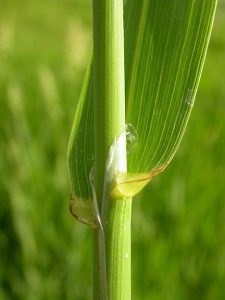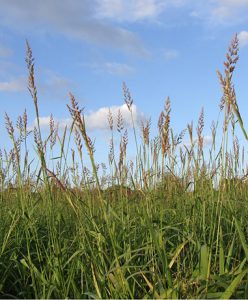Bulletin #2268, Maine Forage Facts: Reed Canary Grass
Bulletin #2268, Maine Forage Facts: Reed Canary Grass (PDF)
By Jaime Garzon, Assistant Extension Professor and Forage Educator, University of Maine Cooperative Extension
For information about UMaine Extension programs and resources, visit extension.umaine.edu.
Find more of our publications and books at extension.umaine.edu/publications/.
Reed Canarygrass
Reed canarygrass (Phalaris arundinacea L.) is a fast-recovering grass useful for intensive pasture programs, hay, and haylage. This is a vigorous, tall-growing grass that adapts to diverse conditions. Until recently, it was primarily used in waterways, ditch banks, and other areas where water stood for part of the year. However, reed canarygrass is also drought resistant. Thus, under proper management, this species does well on upland sites.
The grass spreads from short rhizomes, creating a dense sod. If not grazed or clipped, plants will reach heights exceeding 6 feet under high fertility conditions. The leaf blades are flat and up to 0.75 inches wide and 1.5 feet long. The seed heads are dense, branched panicles that can exceed 8 inches long.
Site selection
Reed canarygrass is found in wet meadows, wetlands, marshes, fens, old fields, floodplains, wet prairies, roadsides, ditch banks, streambanks, lake shores, and shore swales. Any moist, fertile, semi-open to open habitat provides suitable conditions for this species. It is tolerant to soil acidity, but its performance is reduced at a pH lower than 6. After establishment, these stands may exclude and displace desirable native plants and animals.
Soil preparation and establishment
Spring seedings are the most common. However, late-summer seedings are often more successful because weeds are less aggressive. Reed canarygrass is slow to establish and may fail when weed competition is severe during establishment. Grass weeds and sedges are especially harmful. Companion crops can be used for spring seedings but should not be used for late summer seedings. Oats are the most common companion crop, but early removal for silage or grazing is necessary to reduce competition for sunlight and moisture. Due to its tolerance to dry soils, reed canarygrass can be planted in a mixture with alfalfa to increase the productivity of the pasture.
If a late-summer seeding is planned, prepare the seedbed 2 to 4 weeks before seeding. This will allow the soil to become firm and the seedbed to accumulate moisture. The best seeding time is before August 15th in Maine.
Best reed canarygrass stands are obtained when sown not deeper than ½ inch in a well-prepared, firm seedbed. This is best accomplished with band seeders equipped with press wheels or a roller. Cultipacker seeders and grain drills work well if the seedbed is firm. Caution must be used not to bury the seed too deep after broadcast seeding.
Reed canarygrass should be seeded at 8 to 12 pounds per acre when seeded alone. This is a relatively similar seeding rate compared to orchardgrass or timothy; as reed canarygrass seed tends to have a low germination percentage, requiring a high seeding rate. Legume mixtures are recommended, especially for hay or silage production. When seeding reed canarygrass in a mixture, decrease the seeding rate to 6 to 8 pounds per acre.
Liming and fertilization
Lime and fertilizer needs must be determined by soil testing before seeding. Without a soil test, and assuming medium fertility soil, plow down 0-45-135 pounds of nitrogen, phosphorus, and potassium per acre and apply 20-20-20 pounds per acre at seeding.
Reed canarygrass responds better to nitrogen fertilization than the other cool-season grasses. In pure reed canarygrass stands, apply 80 to 240 pounds of nitrogen per acre annually, depending on soil condition and yield potential. Generally, about 40 pounds of nitrogen are required per ton of forage produced. Nitrogen rates over 120 pounds per acre should be applied in split applications. Fertilization systems that apply at least one-half of the annual N in August can be utilized to take advantage of the high-yielding characteristics of reed canarygrass in the fall.
A productive stand of reed canarygrass will require about 30 pounds per acre of phosphorus annually for stand maintenance. Potassium fertilization for maintenance is more variable than phosphorus and may range from 0 to 160 pounds per acre per year, depending on the soil type and cropping history. On higher organic matter soils, higher rates would be necessary.
No N fertilization is needed when seeding with a legume. Over 20 pounds of nitrogen per acre will stimulate reed canarygrass development but inhibit legume establishment.
Varieties
Rival: This variety provides high yields, improved palatability, and very low alkaloid content. It promotes better intake and greater weight gain over common reed canarygrass. Excellent for wet-dry ground with superior performance over older varieties.
Chiefton: High-yielding and low alkaloid variety developed by Dr. Robert Kalton. It is adaptable to cold climates and varied soil conditions, especially wet and flooded areas. Extremely cold-tolerant and winter-hardy.
Productivity

Reed canarygrass grows fast in the spring and heads from late May. Recovery following defoliation is excellent in the spring and early summer and is fair to good in late summer and early fall. However, it is frost-sensitive and will turn brown quickly after early fall frosts.
Reed canarygrass is high-yielding when cut for hay or silage (2 to 4 tons dry matter per acre). The highest yield is obtained when harvested at heading. In contrast, the highest quality is obtained before seed heads appear and decline rapidly afterward. Regrowth after harvesting will be leafy with stem elongation, but no seed heads will be produced, so it will need special careful when deciding the next cut, to avoid nutritive value loss.
Grazing management
Excessive forage growth must be avoided when using reed canarygrass for pasture to maintain quality and palatability. This species usually has less palatability than other cool-season grasses, and animals often prefer other forages, especially if the reed canarygrass is highly alkaloid or overmatured before grazing. Growth starts early in the spring, with grazing generally available by the second or third week in May. Maintain the grass below 12 inches tall during the rapid spring growth. Short-duration rotational grazing with a heavy grazing pressure will allow the best utilization and greatest animal gains per acre. In addition, rotational grazing is recommended to enable hay harvesting of ungrazed pastures during the spring. Reed canarygrass should not be grazed below than four inches above the ground. A recovery period following grazing will also improve productivity.
Additional Resources
- Bulletin #2262, Forage Facts: Growing Forage Grasses in Maine
- Bulletin #2263, How Maine Farmers Can Determine if They Have Enough Hay and Forage for the Winter
- Bulletin #2272, Forage Facts: Selecting Forage Crops for Your Farm
References
Hall M. (1993). Reed Canarygrass. Pennsylvania State University Extension. University Park (PA), United States.
Iowa State University. (2020). Reed Canarygrass invasive species profile. Extension and Outreach. Ames (IA).
Thomas-Murphy J, Amsili J, Bergstrom G, Cherney J, Hansen J, Helms M, Hunter M, Kettering Q, Lawrence J, van Es H, Smith E, Smith M, Stanyard M, Workman K. (2023). Cornell Guide for Integrated Field Crop Management. University of Cornell Cooperative Extension. Ithaca (NY), United States. pp 96-97.
University of Wyoming. (2023). Forage identification: Reed Canarygrass. Laramie (WY).
Information in this publication is provided purely for educational purposes. No responsibility is assumed for any problems associated with the use of products or services mentioned. No endorsement of products or companies is intended, nor is criticism of unnamed products or companies implied.
© 2023
Call 800.287.0274 (in Maine), or 207.581.3188, for information on publications and program offerings from University of Maine Cooperative Extension, or visit extension.umaine.edu.
In complying with the letter and spirit of applicable laws and pursuing its own goals of diversity, the University of Maine System does not discriminate on the grounds of race, color, religion, sex, sexual orientation, transgender status, gender, gender identity or expression, ethnicity, national origin, citizenship status, familial status, ancestry, age, disability physical or mental, genetic information, or veterans or military status in employment, education, and all other programs and activities. The University provides reasonable accommodations to qualified individuals with disabilities upon request. The following person has been designated to handle inquiries regarding non-discrimination policies: Director of Equal Opportunity, 5713 Chadbourne Hall, Room 412, University of Maine, Orono, ME 04469-5713, 207.581.1226, TTY 711 (Maine Relay System).


